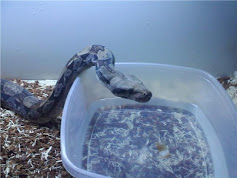 Brazilian Rainbow Boa
Brazilian Rainbow BoaTaxonomyOrder: Squamata Family: Boidae Genus/species: Epicrates cenchria cenchria
DescriptionThe Brazilian rainbow boa is one of about 12 named subspecies of rainbow boa. There is, however, much debate about the number of subspecies.
The Brazilian rainbow boa is a round-bodied terrestrial boa of medium build. The head is not particularly large, but it is distinctly wider than the neck. It is soft-skinned with great iridescence in its skin. Brazilian rainbow boas are brown or reddish brown. There are three parallel black stripes on the top of the head and large black rings down the back that give the appearance of dorsal blotches. The round lateral blotches are black with an orange or reddish crescent across the top. There is a great deal of variation in color and marking among individuals of this species. Many consider this one of the world’s most beautiful snakes.
Adult males have substantially larger spurs along the side of the vent and also have noticeably thicker bases of their tails due to the invaginated hemipenes. These boas range from four to six feet (1.2 to 1.8 m) in length.
Distribution and HabitatRainbow boas are widespread throughout much of South America. Brazilian rainbow boas occur in the Amazon Basin, and in coastal Guiana, French Guyana, and Suriname and southern Venezuela. They live in humid woodland forests and can sometimes be found in open savannas.
Diet in the WildIn the wild the diet consist of rodents, birds, and possibly some forms of aquatic life and lizards.
Zoo DietThe boa is fed rats and chicks.
ReproductionSexual maturity is usually reached in the first 2.5 to four years. Males may breed at four feet (1.2 m) and females at 4.5 feet (1.4 m). Gestation lasts about five months. Baby Brazilian rainbows are born live in litters of two to 35. A typical litter contains twelve to 25 babies. The babies are usually 15 to 20 inches (38 to 51 cm) long. Yearlings often grow to four feet (1.2 m) in length, though 36 to 40 inches (91 to 100 cm) is more typical. Females seem to eat more and grow larger than males.
Life SpanThey may live up to 20 years in captivity.
StatusThis snake does not have any special status. Brazilian rainbow boas occur naturally across much of the northern half of South America. They were exported in fair numbers from Suriname during the 1980s and early 1990s. They are now exported in much more limited numbers and most specimens offered for sale today are captive bred.
Fun FactsRainbow boas are so named because of the iridescent sheen imparted by microscopic ridges on their scales, which act like prisms to refract light into rainbows.
Boa.jpg)



No comments:
Post a Comment